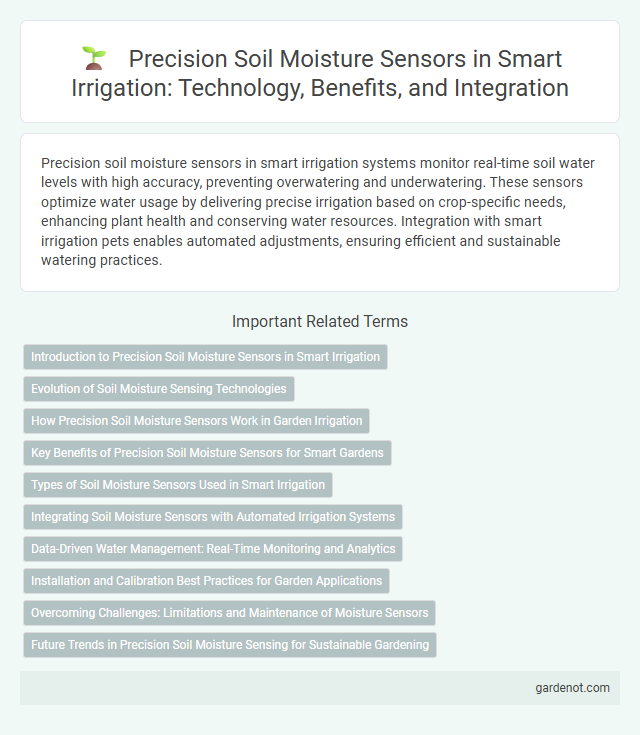Precision soil moisture sensors in smart irrigation systems monitor real-time soil water levels with high accuracy, preventing overwatering and underwatering. These sensors optimize water usage by delivering precise irrigation based on crop-specific needs, enhancing plant health and conserving water resources. Integration with smart irrigation pets enables automated adjustments, ensuring efficient and sustainable watering practices.
Introduction to Precision Soil Moisture Sensors in Smart Irrigation
Precision soil moisture sensors are integral to smart irrigation systems, providing accurate real-time data on soil water content to optimize irrigation scheduling. These sensors utilize advanced technologies such as capacitive, resistive, or time-domain reflectometry to measure moisture levels at varying soil depths, ensuring precise water delivery tailored to crop needs. Implementing precision soil moisture sensors enhances water use efficiency, reduces wastage, and improves crop yield by maintaining optimal soil moisture conditions.
Evolution of Soil Moisture Sensing Technologies
Precision soil moisture sensors have evolved from basic tensiometers to advanced capacitive and dielectric sensors, offering higher accuracy and real-time data essential for smart irrigation systems. Modern sensors integrate wireless communication and IoT technologies, enabling precise water application tailored to specific crop needs and soil conditions. This evolution reduces water waste and enhances crop yield by providing farmers with detailed insights into soil moisture dynamics.
How Precision Soil Moisture Sensors Work in Garden Irrigation
Precision soil moisture sensors measure the volumetric water content in soil by emitting electrical signals through probes inserted at root-zone depths, providing real-time data on moisture levels. These sensors use capacitance or resistive technology to detect changes in the dielectric constant of soil, enabling accurate irrigation scheduling tailored to specific plant needs. Integrating these sensors with smart irrigation systems ensures efficient water use, reduces waste, and promotes healthier plant growth in garden environments.
Key Benefits of Precision Soil Moisture Sensors for Smart Gardens
Precision soil moisture sensors enhance smart gardens by providing accurate, real-time data on soil hydration levels, enabling optimized irrigation schedules that conserve water and promote healthy plant growth. These sensors prevent overwatering and underwatering, reducing plant stress and improving overall crop yield. Integration with smart irrigation systems ensures automated, efficient water use tailored to specific plant needs, maximizing resource efficiency and sustainability.
Types of Soil Moisture Sensors Used in Smart Irrigation
Capacitive soil moisture sensors measure volumetric water content by detecting changes in dielectric constant, offering high accuracy and low power consumption for smart irrigation systems. Resistive sensors gauge soil moisture through electrical resistance variations between probes, providing cost-effective and durable solutions despite potential corrosion issues. Time Domain Reflectometry (TDR) sensors analyze the travel time of electromagnetic pulses in soil, delivering precise moisture readings ideal for optimizing water use in advanced irrigation management.
Integrating Soil Moisture Sensors with Automated Irrigation Systems
Integrating precision soil moisture sensors with automated irrigation systems ensures real-time monitoring of soil water content, enabling targeted water application that reduces waste and enhances crop health. These sensors provide accurate, location-specific data by measuring volumetric water content, allowing irrigation controllers to adjust schedules based on soil moisture thresholds. Advanced integration with IoT platforms facilitates remote management and data analytics, optimizing water use efficiency in smart irrigation practices.
Data-Driven Water Management: Real-Time Monitoring and Analytics
Precision soil moisture sensors enable data-driven water management by providing real-time monitoring and analytics of soil hydration levels. These sensors deliver accurate, continuous data that allows for optimized irrigation schedules, minimizing water waste and enhancing crop health. Integration of sensor data with automated irrigation systems supports efficient resource use and sustainable agricultural practices.
Installation and Calibration Best Practices for Garden Applications
Installing precision soil moisture sensors in garden applications requires placing the sensor at root-zone depth, typically 6 to 12 inches below the soil surface, to ensure accurate moisture readings. Calibration involves comparing sensor data with manual soil moisture measurements and adjusting sensor thresholds for local soil types, which can vary from sandy to clay soils. Regular recalibration, especially after soil disturbance or seasonal changes, maintains optimal irrigation schedules and conserves water effectively.
Overcoming Challenges: Limitations and Maintenance of Moisture Sensors
Precision soil moisture sensors face challenges such as calibration inaccuracies, sensor drift, and physical damage due to environmental factors, which can affect data reliability in smart irrigation systems. Regular maintenance, including cleaning sensor probes and recalibrating devices, helps sustain measurement accuracy and prolong sensor lifespan. Advances in sensor technology, such as self-calibrating features and robust materials, further mitigate limitations and enhance performance in varying soil conditions.
Future Trends in Precision Soil Moisture Sensing for Sustainable Gardening
Advancements in precision soil moisture sensors leverage AI-powered data analytics and IoT connectivity to deliver real-time, hyper-accurate moisture readings, optimizing water usage in sustainable gardening. Emerging nano-sensor technologies and wireless sensor networks enhance sensitivity and scalability, enabling seamless integration with smart irrigation systems for environment-friendly water conservation. Future trends emphasize energy-efficient designs and predictive analytics to anticipate plant hydration needs, reducing waste and promoting healthier plant growth.
Precision soil moisture sensor Infographic

 gardenot.com
gardenot.com